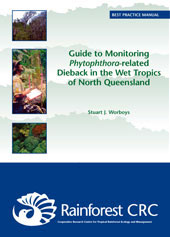 |
|||||
 |
Back to Research Report Series |
||||
| Report
No. 42 Guide to Monitoring Phytophthora-related Dieback in the Wet Tropics of North Queensland Best Practice Manual Stuart J. Worboys ISBN 0 86443 755 2 |
|||||
| Extract
from Introduction Dieback caused by Phytophthora cinnamomi has had a devastating effect on forests, heathlands and woodlands across the wetter areas of Australia. The pathogenic fungus-like organism is believed to have been introduced during European settlement and now affects hundreds of thousands of hectares of native vegetation, impacting significantly on biodiversity values and threatening the survival of some species. In response to the threat it poses to biodiversity, P. cinnamomi has been identified as a 'Key Threatening Process' under the Commonwealth's Environment Protection and Biodiversity Conservation Act 1999. A national Threat Abatement Plan has also been developed to prioritise actions for its control. This guide to monitoring Phytophthora-related dieback establishes the procedures for collecting data from monitoring sites. It details the methods that are to be used in collecting data so that information can be compared between years. It also includes: |

|
||||
|
|||||
|
|
|||||
| Monitoring
sites have been established throughout the Wet Tropics and two tree health
assessments have been carried out by James Cook University. It is anticipated
that the Queensland Parks and Wildlife Service will take a leading role
in coordinating future monitoring events. Download file is a PDF document that is designed to be printed using the duplex feature on your printer (i.e. double-sided). |
|||||
| Back to top | |||||
 |
|||||